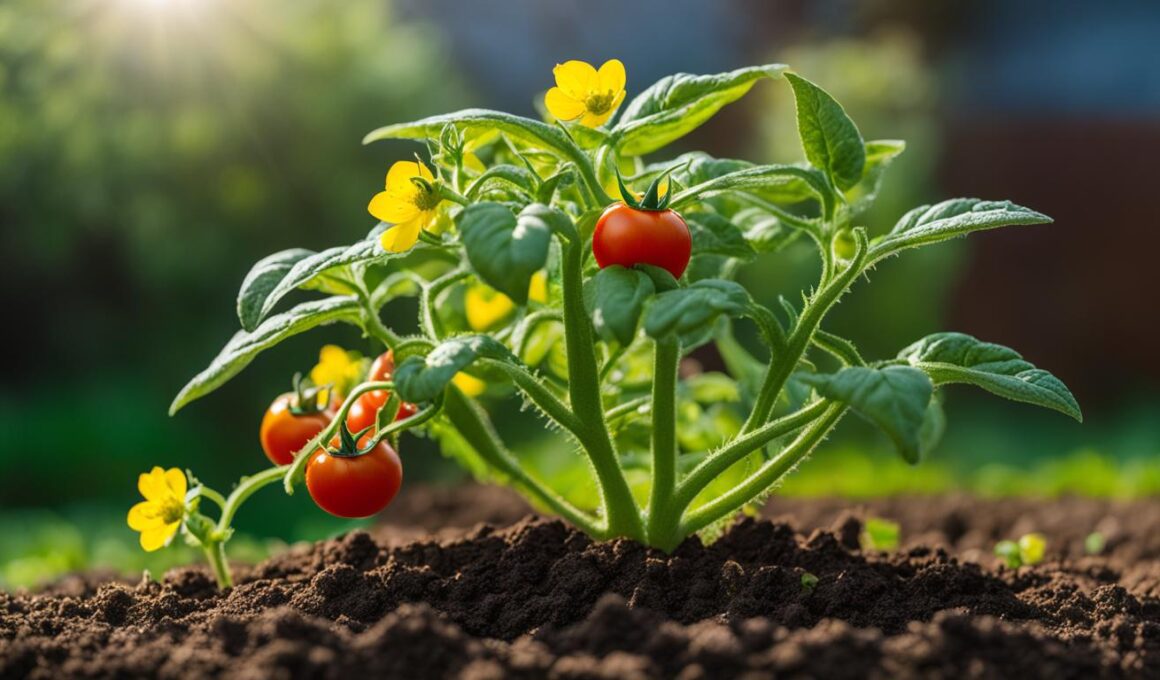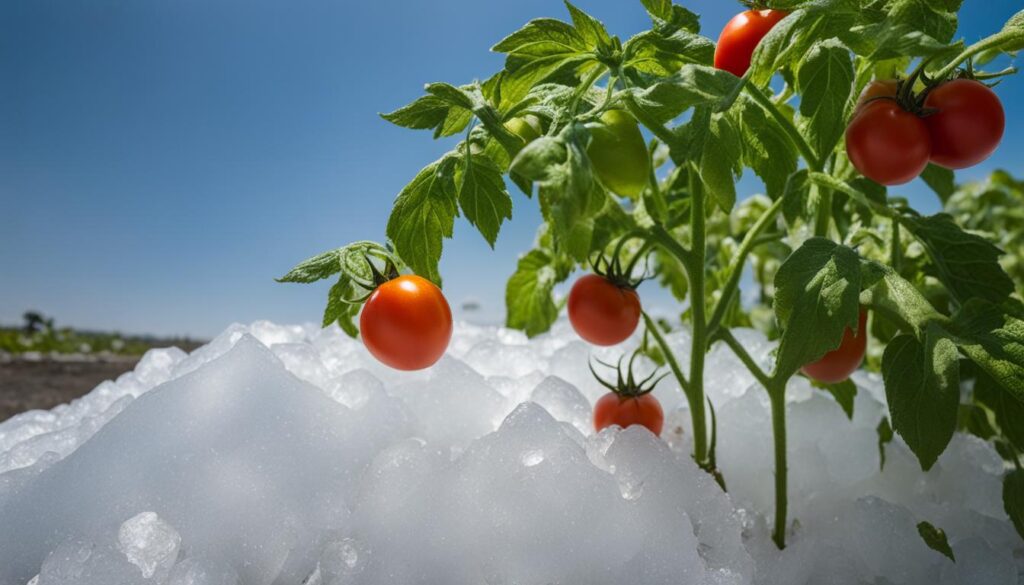If you’re facing the frustration of your tomato plants not flowering, don’t worry. There are solutions to help you increase flowering and maximize your tomato harvest. Understanding the factors that affect tomato flowering can help you address the issue and promote a successful growing season.
One common reason for a lack of flowers is insufficient pollination. To improve pollination, consider allowing bees or other insects to visit your plants. You can also take matters into your own hands by manually shaking the plants to dislodge pollen. This can help ensure that the flowers are properly pollinated and develop into fruit.
High heat levels can also inhibit flowering in tomatoes. During hot weather, it is crucial to keep your plants cool and well-watered. Additionally, insufficient light can negatively affect flowering. Make sure your tomato plants are receiving enough sunlight or consider using a grow light to supplement their light requirements.
Fertilizer and nutrient issues can also impact tomato flowering. It is important to provide your plants with the proper nutrients they need for healthy growth and flower production. Imbalances in fertilizer or inadequate nutrient uptake can hinder flowering. Ensuring your tomato plants receive the proper fertilization and nutrient levels can make a significant difference in their ability to flower.
By addressing these factors that affect tomato flowering, you can increase the chances of successful pollination, promote flower development, and ultimately enjoy a bountiful tomato harvest. Follow these tips and strategies to improve tomato flowering and boost the productivity of your plants.
Tips for Improving Tomato Flowering
To increase pollination in tomatoes, there are a few techniques you can employ. One method is hand-pollination, which involves transferring pollen from the male flowers to the female flowers using a paintbrush. This can be especially useful when pollinators like bees are scarce. Encouraging the presence of pollinating insects, such as bees, can also help enhance pollination rates. By providing a diverse range of flowering plants in your garden, you can attract these beneficial insects to visit your tomato plants and increase the chances of successful pollination.
Protecting your tomatoes from extreme temperature fluctuations is crucial for promoting flowering. High heat levels can inhibit flower production, so it’s important to shield your plants from the scorching sun during the hottest parts of the day. Consider applying a protective shade cloth over your tomato plants or providing temporary shade using a pergola or umbrella. Conversely, cold snaps can also negatively impact flowering, so cover your plants with frost blankets or relocate container-grown tomatoes to a sheltered area when frost is expected.
Proper watering is essential for promoting tomato flowering. Both overwatering and underwatering can disrupt the delicate balance of moisture and nutrients necessary for optimal flower production. To ensure proper watering, aim for a deep, thorough soak that penetrates the root zone of the plant. This encourages the roots to grow deeper and access nutrients needed for flowering. Make sure to maintain consistent moisture levels in the soil, as fluctuations can stress the plant and hinder flower formation.
Fertilizing tomatoes at the right time and with the right nutrients can significantly increase flowering. When planting, use a balanced NPK fertilizer to provide a good foundation of nitrogen, phosphorus, and potassium. After the plants have established and started flowering, transition to a fertilizer with higher levels of phosphorus and potassium, which are essential for flower development. Avoid excessive nitrogen, as it can promote vegetative growth at the expense of flowering.
Example of Improved Tomato Plant Flowering
Let’s say you’ve implemented these tips for improving tomato flowering in your garden. You’ve hand-pollinated the flowers, attracting bees, and other pollinators to your tomato plants. Additionally, you’ve protected your plants from temperature extremes by providing shade during hot weather and covering them during cold snaps. You’ve adjusted your watering practices to ensure consistent moisture levels without overwatering or underwatering. Lastly, you’ve fertilized your tomatoes with the appropriate nutrients, supplying them with balanced nutrition for optimal flower production.
As a result of these efforts, you’ll likely observe an increase in the number of flowers on your tomato plants. These flowers will transform into fruit, ultimately leading to a more abundant harvest. With improved tomato flowering, you can enjoy a bountiful crop of delicious, homegrown tomatoes.
Conclusion
Improving tomato flowering is essential for increasing fruit production in tomatoes. By troubleshooting common issues such as insufficient pollination, high heat levels, insufficient light, and nutrient imbalances, you can enhance flower production in your tomato plants.
Implementing practical tips like hand-pollination, protecting your plants from temperature extremes, ensuring proper watering, and timely fertilization can significantly maximize fruit production in tomatoes. By taking proactive measures to address these challenges, you can guarantee a successful tomato growing season.
Enjoy a bountiful harvest of delicious tomatoes by actively working to enhance flowering, resolving any obstacles that may hinder the process. By implementing these strategies, you can achieve noticeable improvements in your tomato plants’ flowering and fruiting, allowing you to savor the satisfaction of a thriving tomato garden.
Can the Techniques for Increasing Flowering in Tomatoes also be Applied to Help Ponytail Palm Grow Taller?
Yes, the techniques for increasing flowering in tomatoes can also be applied to help the growing taller ponytail palm. Providing the right amount of sunlight, water, and nutrients will encourage vertical growth in the ponytail palm, just as it promotes more flowers in tomatoes. Consistent care is key for both plants.










